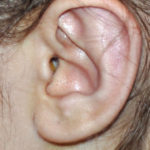The ear may be quite small, measuring only about 5 cms in height and 3 cms in width, but it has the most complex anatomy of any facial component. Its many ridges and convolutions comprised only of cartilage (and the overlying skin), surrounding the ear hole, give it a distinct shape that is uniquely recognizeable as an ear. But within its complex geometries lie some basic architecture that guides how otoplasty (ear pinning) or ear reconstructive surgery is done.

In otoplasty, often called ‘pinning back the ears’, the anithelix is missing. (the fold is not there) So to move the ears back, the cartilage from behind is sewn closer together to make an antihelix or antihelical fold, thus moving the helix and ear back closer to the head. How snug or loose these shaping sutures are placed determines how close the ear sits to the side of the head. In some cases of protruding ears, the bowl or concha is also too big. So the concha from behind may be cut down in size by cutting out a wedge or sewn directly back, this also moving the ear back. Since otoplasty is mainly about shaping the cartilage with sutures, this is why it is a simple and fairly quick operation…but with a very powerful visual effect.
Conversely, ear reconstruction can be quite complex. In children born with much or all of their ear missing (known as microtia), complex cartilage grafting must be done. This often involves taking rib cartilages, putting them together, and carving out an ear framework. And how is the framework pieced together and carved? Based on the three-tier principle of ear architecture! Helix, antihelix, and concha.While ear reconstruction is multiple stages and is not based solely on the cartilage framework that is put under the skin, it all begins with a well-fabricated cartilage framework. Onto that are finer details of the lobule and other shaping procedures (more minor) which are done later.
Dr Barry Eppley
Indianapolis, Indiana


